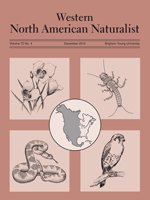Postfire revegetation with native perennial grasses is difficult to achieve in disturbed arid rangelands. If local populations are adapted to current conditions, then locally collected seed would be predicted to have higher survival than nonlocal seed, and using local seed should improve revegetation success. However, for revegetation projects in the Great Basin, sufficient quantity of local seed is often difficult to obtain commercially, so seeds often originate from source populations that are hundreds of kilometers from the project site. We investigated whether seed source affected first-year establishinent of big squirreltail (Elymus multisetus M.E. Jones) seedlings in a common garden field trial 50 km north of Reno, Nevada. For the trial, we used wild, locally collected seed and commercially produced seed originating from Oregon, Idaho, and California. Several phenological and growth traits varied significantly between source populations. Eighty-six percent of local seeds emerged, compared to 71%, 61%, and 12% of seeds from Idaho, Oregon, and California, respectively. Local seeds emerged, on average, 9 days earlier than seeds from other sources. Fourteen percent of the local seedlings survived through the first year, exceeding survival by Oregon (12%), Idaho (8%), and California (2%) seedlings. Though survivorship was highest for local seed, local seedlings were smaller, producing 24% fewer leaves than the most productive seedlings from the Idaho seed source. Our data suggest that seed source is an important factor in seedling establishment. If local seed can survive significantly better than regionally collected, commercially produced seed, it may be both ecologically and economically beneficial to use local seed in revegetation.
How to translate text using browser tools
1 December 2012
Seed Source Affects Establishment of Elymus multisetus in Postfire Revegetation in the Great Basin
Courtney L. J. Rowe,
Elizabeth A. Leger
ACCESS THE FULL ARTICLE





